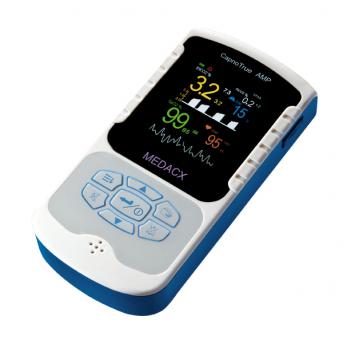MEDACX supplies a range of dedicated veterinary monitors and sensors designed specifically for use on animals.
its technology you can trust
Whilst pulse oximeters monitor oxygen saturation in anaesthetized animals, hypercapnia occurs more commonly than hypoxemia.
How to measure hypercapnia and its importance
Normal ETCO2 levels are 4.6 - 6 kPa (35-45 mmHg). The most common cause of increased ETCO2 is hypercapnia secondary to anesthetic-induced hypoventilation. Normal healthy animals can tolerate some increase in carbon dioxide levels (up to 7.9 - 9.3 kPa) without suffering detrimental effects. Extremely high carbon dioxide levels (> 13.3 kPa) can cause narcosis and exacerbate deep levels of anesthesia. The simplest way to correct high ETCO2 is to simply ventilate (“bag”) the animal more frequently.
Low ETCO2 levels are most commonly a result of hyperventilation or diluted exhaled carbon dioxide caused by high oxygen flow rates such as those used with non-rebreathing systems. Sudden significant reductions in ETCO2 can be due to airway occlusion, ET tube dislodgement, disconnection or cardiac arrest. Capnometers are also useful during CPR to determine ETCO2 production as an indicator of return of CO2 production and blood flow through the lungs.
Valuable tool for Cardio Pulminary Resucitation
End-tidal CO2 concentration (ETCO2) may serve as a simple noninvasive measurement of the blood flow generated by precordial compression during cardiopulmonary resuscitation (CPR). Animals successfully defibrillated after 12 min of CPR demonstrate an immediate increase in ETCO2, therefore ETCO2 serves as a noninvasive measure of pulmonary blood flow. Accordingly, ETCO2 prognosticates outcome during CPR and immediately identifies restoration of spontaneous circulation (ROSC).
Sidestream or Mainstream monitor?
Portable monitors are available to measure exhaled CO2. These units consist of a monitor with a pump (to obtain respiratory gases), and a sampling line with an adaptor that attaches between the endotracheal tube and the breathing hose [Sidestream devices].
Capnometers and Waveform Capnographs are available as either mainstream or sidestream devices. Mainstream devices sample the gas at the airway without diverting it into a monitoring unit while sidestream devices divert gas from the airway into a monitoring unit for sampling.


